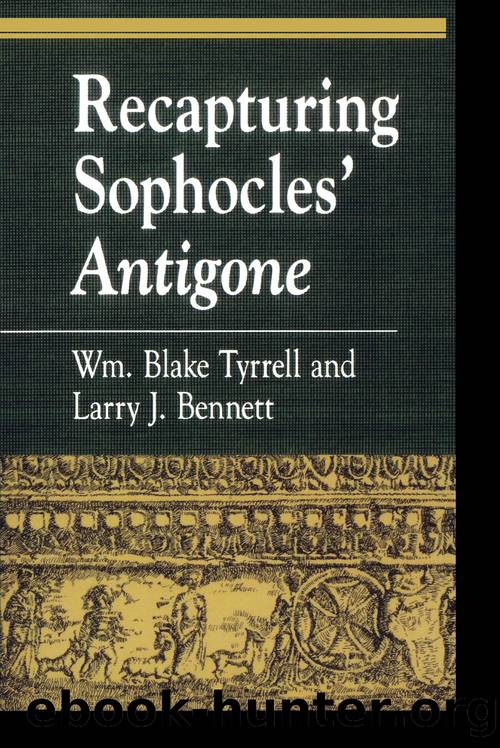Recapturing Sophocles' Antigone by Tyrrell William Blake. Bennett Larry J. & Larry J. Bennett

Author:Tyrrell, William Blake.,Bennett, Larry J. & Larry J. Bennett
Language: eng
Format: epub
Publisher: Rowman & Littlefield Publishing Group, Inc.
Published: 1998-01-15T00:00:00+00:00
5. Haemon, Son and Citizen
Second Stasimon and Third Episode (582-780)
Because Antigone, like all Greek tragedy, used only three actors, the reader may have the impression that the spectacle was sparse. But in the scene just concluded, Creon is attended by at least two servants (Sophocles Antigone 491), Antigone stands before him, the Watchman having been dismissed, and Ismene is accompanied by female servants who, since they escort her back into the house (578), must have entered with her. Now, all have disappeared save for Creon who remains visible before the house. The contrast could hardly have failed to strike Sophoclesâ original audience and bears noting by his modern audiences. The spectacle foreshadows Creonâs fate, and the eldersâ song reinforces what they see.
The elders begin their song with an adynaton about the fortunate, a one-line generalization that contains its own untruth, for what life has âno taste of troublesâ (κακῶν á¼Î³ÎµÏ ÏÏÎ¿Ï Î±á¼°á½½Î½ Sophocles Antigone 583)?1 Not surprisingly, they quickly turn their attention to those whose house is incessantly afflicted with recklessness, ruin, and delusion, that is, with atê from the gods that creeps over the house like a wave driven by storm winds of Thrace (584-592).2 Behind them stands such a house whose succeeding generations bring no release from pain. They speak of the doom awaiting its final progeny:
νῦν Î³á½°Ï á¼ÏÏá½±ÏÎ±Ï á½Ïá½²Ï
á¿¥á½·Î¶Î±Ï á¼Ïá½³ÏαÏο Ïá½±Î¿Ï á¼Î½ ÎἰδίÏÎ¿Ï Î´á½¹Î¼Î¿Î¹Ï·
καÏâ αὠνιν Ïοινία
θεῶν Ïῶν νεÏÏá½³ÏÏν á¼Î¼á¾· κόνιÏ,
Î»á½¹Î³Î¿Ï Ïâ á¼Î½Î¿Î¹Î± καὶ ÏÏενῶν á¼ÏινύÏ.
Sophocles Antigone 599-603
Now, above the last
root a light had been stretched over Oedipusâ house.
Again the bloody dust3
of nether gods mows it down,
folly of word and Erinys of mind.
The promise of continuity is broken. Underworld gods, because of foolish words spoken by a deluded mind, are preparing to destroy âthe last rootâ of the house. The gist of the eldersâ message is clear, yet its structure and imagery have elicited much controversy and therefore warrant elaboration.
After a clear reference to the continual suffering of âthe house of Labdacusâ sonsâ (Sophocles Antigone 594), the elders regard the fate of the present generation, the âNowâ that rests in Antigone. The pluperfect tense of the verb indicates that the hope that had been vested in Antigone is lost. The âbloody dust,â reminiscent of that which covered the âoozingâ body of Polyneices (Î¼Ï Î´á¿¶Î½ 410), is now the instrument of revenge of the nether gods.4 The image of dust mowing down a root must have been palpable to an audience living in a land where dust or sand was ubiquitous and dust storms plagued its dry season,5 particularly since they had just heard such a storm vividly described, a storm that injured men and âall the foliage of the trees on the plainsâ (ÏᾶÏαν . . . Ïόβην / á½Î»Î·Ï ÏÎµÎ´Î¹á½±Î´Î¿Ï 419-420). The dust belongs to the nether gods who are concerned with both the unburied dead and the honors due themselves. Though a root is more likely to be âmowed down,â in the world of metaphor, the âitâ (nin) of line 601 could refer to either root or light and has been read as both.
Download
This site does not store any files on its server. We only index and link to content provided by other sites. Please contact the content providers to delete copyright contents if any and email us, we'll remove relevant links or contents immediately.
The Miseducation of Cameron Post by Emily M. Danforth(959)
Imperial Hotel: A Historical Lesbian Romance by Diane Marina(740)
The Miseducation of Cameron Post by emily m. danforth(709)
Happy Birthday, Wanda June by Kurt Vonnegut(643)
The Complete Works of Jane Austen (In One Volume) Sense and Sensibility, Pride and Prejudice, Mansfield Park, Emma, Northanger Abbey, Persuasion, Lady Susan, the Watson's, Sanditio by Jane Austen(519)
The Complete Works of Oscar Wilde: 150+ Titles in One Edition by Oscar Wilde(511)
Better Places to Go by David-Matthew Barnes(494)
Faithful Valor by Isabella(490)
Halfway Bitches Go Straight to Heaven (TCG Edition) by Stephen Adly Guirgis(461)
Timed Romance by K'Anne Meinel(432)
Damaged in Service by Barrett(415)
WRECKED by Serafina Jax(385)
I Won't Remember You (Aidan & Vicky Book 6) by Mairsile Leabhair(348)
Doira'Liim (The Beautiful Whisper of the Goddess Saga) by Orr Krystal(331)
The Wild Duck by Henrik Ibsen--Delphi Classics (Illustrated) by Henrik Ibsen(331)
The World's Desire by H. Rider Haggard && Andrew Lang(320)
Delphi Complete Works of W. Somerset Maugham (Illustrated) by William Somerset Maugham(289)
The Bourgeois Gentleman by Molière(280)
The Liberators of Willow Run by Marianne K. Martin(276)
